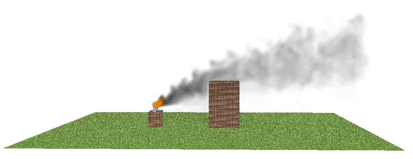A New Take on Air Dispersion Modeling: Re-Entrainment Evaluations
Posted: December 1st, 2016
Authors: Amanda E.
Facilities are typically introduced to the world of air dispersion modeling when they are required to demonstrate that a proposed project will not exceed regulatory thresholds, such as maximum allowable air toxics screening levels or the National Ambient Air Quality Standards (NAAQS). However, over the past year, ALL4 has been using air dispersion modeling for another purpose: re-entrainment evaluations. Re-entrainment is an atmospheric event that occurs when suspended particles or compounds that are exhausted in a plume are carried back into a plume of air (you may recognize the term if you have a background in cloud physics or chemistry).  In our projects, we have been interested in understanding how emissions of nitrogen oxides (NOX) from emergency generators, boilers, and/or combined heat and power (CHP) units, for example, can get re-entrained into a building through the fresh air intake system. We utilize air dispersion modeling to predict the concentration of pollutants of concern at these air intakes and compare the predicted concentrations with the NAAQS and published health guidelines, like those from the Occupational Safety and Health Administration (OSHA) or American Conference of Governmental Industrial Hygienists (ACGIH). While the NAAQS were developed for ambient air external to buildings, they are concentrations deemed to be acceptable to human and environmental health and therefore can be used as another threshold, in addition to the health guidelines, to which ALL4 can compare re-entrainment modeling results.
In our projects, we have been interested in understanding how emissions of nitrogen oxides (NOX) from emergency generators, boilers, and/or combined heat and power (CHP) units, for example, can get re-entrained into a building through the fresh air intake system. We utilize air dispersion modeling to predict the concentration of pollutants of concern at these air intakes and compare the predicted concentrations with the NAAQS and published health guidelines, like those from the Occupational Safety and Health Administration (OSHA) or American Conference of Governmental Industrial Hygienists (ACGIH). While the NAAQS were developed for ambient air external to buildings, they are concentrations deemed to be acceptable to human and environmental health and therefore can be used as another threshold, in addition to the health guidelines, to which ALL4 can compare re-entrainment modeling results.
So what prompts this kind of evaluation? A re-entrainment evaluation is not required under any Federal or state air quality regulation; it is instead a consideration during the design phase of a capital project or in response to comments about odor in an existing facility. To date, our experience has revolved around healthcare facilities and the following capital projects, but this evaluation can apply practically anywhere:
- The construction of a brand new facility.
- The addition of a new wing or patient tower to an existing facility.
- The replacement of existing equipment at a facility.
- The addition of new equipment at a facility.
While it is important to understand the potential for re-entrainment in any industry, the distinction about healthcare facilities, such as hospitals, is that the same people (e.g., patients, doctors) may occupy them 24-hours per day and for extended periods of time. In addition, patients make up a sensitive population in a concentrated area. The re-entrainment evaluation aims to identify whether there is a potential to expose this population to products of combustion and other contaminants through re-entrainment. The results of the re-entrainment evaluation can shape design choices, such as equipment type, location, and/or stack parameters, if the results of the modeling are unfavorable. Thus, it is important to set up an accurate model and complete the evaluation during the design phase of a project.
To evaluate the potential for re-entrainment, ALL4 uses the American Meteorological Society/Environmental Protection Agency Regulatory Model (AERMOD). The re-entrainment modeling is completed similar to a NAAQS analysis, such that the model requires 5-years of representative meteorological data, equipment stack parameters and location, building information, and receptors. The meteorological data can be downloaded from the National Weather Service, but must be processed prior to use. The stack parameters include height, diameter, exhaust temperature, exhaust velocity, and of course, emissions rates for the pollutants of concern. Building information is extremely important since we need to represent building downwash as accurately as possible. This includes building layouts, dimensions, and heights, including the heights of varying tiers. The receptors are the specific fresh air intake locations, so that AERMOD can predict the concentrations at those points of entry into the facility.
Since these evaluations usually involve only a small number of receptors and a handful of sources, the run time of the model is fast. The intricacies of this type of air dispersion modeling occur in the data gathering and model set up. For example, the model should be set up for both “worst case” and “normal” operating scenarios of the modeled sources to reflect situations like routine testing and power outages. Therefore, the model must be run several times for a re-entrainment evaluation to vary the number of units operating, fuel type, and system loads. Hence, it is important to identify all contributing sources of emissions and how they operate. We have even modeled a helipad, by estimating emissions from an idling helicopter.
As for the actual emissions and report, so far we have modeled carbon monoxide (CO), NOX, and surrogates for volatile organic compounds (VOC), like formaldehyde, to compare the predicted concentrations at the air intake receptors with the published health guidelines. This type of evaluation involves post processing of the results of the air dispersion modeling to compare with the guidelines, and finally a presentation of values, comparisons, and corresponding operating scenarios in the final report.
Re-entrainment evaluations are a new spin on typical air dispersion modeling, focusing on the potential for exposure to emissions that could be pulled back into a building through the fresh air intake system, as opposed to assessing off-site impacts. If you are at a facility and have concerns about re-entrainment, or at an engineering firm responsible for the design of a facility, such as a hospital, consider enlisting ALL4 to perform a re-entrainment evaluation. The evaluation could identify potential problems in time to make adjustments and demonstrate your due diligence. Sometimes the potential for an exposure issue can be avoided by raising a stack height a few feet or turning a generator around. Seems like a small price to pay to protect human health – I know our clients have appreciated the peace of mind! Give me (610.933.5246 x129, aessner@all4inc.com) or Sharon Sadler (x503, ssadler@all4inc.com) a call if you are interested in learning more!

